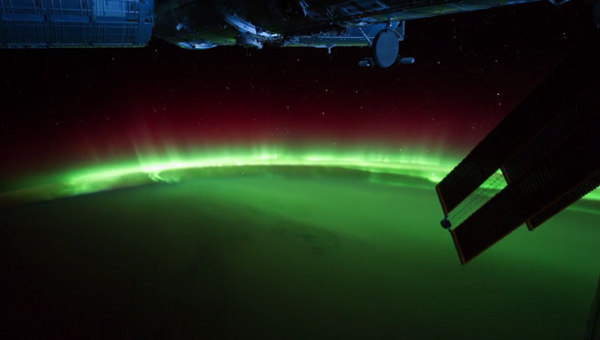What Does Earth Look Like from the Space Station?

For all those who've ever yearned to look out the window of the International Space Station and see the magnificent Earth pass by beneath it, an incredible new video offers a five-minute glimpse. And it's even more breathtaking than you might have guessed.
Designer and artist Michael König of Berlin, Germany, created this time-lapse sequence of photographs taken by Ron Garan, Satoshi Furukawa and the crew of expeditions 28 and 29 onboard the International Space Station from this past August to October. König believes the photos of Earth were taken from 217 miles (350 kilometers) up — a typical orbital altitude for the International Space Station (ISS) — and says they were captured at a rate of 25 pictures per second.
Very little color adjustment or other digital editing was done to the images before they were stitched together, "since in my opinion, the original footage itself already has an almost surreal and aesthetical visual nature," König explained at Vimeo, the site where he uploaded the video. However, he sped up the footage so that "this is way faster than realtime," he told Life's Little Mysteries.
Perhaps the most striking feature of the scenery is the nonstop display of auroral lights dancing above Earth's surface. The video begins with the Aurora Borealis — the Northern Lights — flickering above the United States. It later shows the Aurora Australis, the Borealis' dazzling southern counterparts, above Australia.
These auroras are triggered by charged particles from the solar wind interacting with Earth's atmosphere. When the particles — a mix of electrons and positively charged ions — reach Earth from space, they travel toward Earth's poles along the planet's magnetic field lines. Many of them collide with atoms (primarily oxygen and nitrogen) in a high-altitude layer of the atmosphere called the thermosphere. This excites the atoms, causing them to emit particles of light, or photons.
Nitrogen atoms emit photons with blue and red wavelengths, and oxygen atoms emit green or brownish-red light. Altogether, these emissions produce the bright bands of light known as auroras.
Astronauts onboard the ISS frequently witness and photograph these stunning light displays. In July, astronauts on the space station and space shuttle Atlantis took a series of incredible aurora photos from the ISS.
Sign up for the Live Science daily newsletter now
Get the world’s most fascinating discoveries delivered straight to your inbox.
Viewers might be amazed to learn how clearly astronauts can see city lights, too — especially those along heavily populated coastlines. The twinkling coasts make it easy to see the outline of the United States, Africa, Australia and many other places. At 2:40 in the video, for example, one sees the ISS pass over the Nile River at dusk. Artificial lights can be seen flanking the river banks, creating a ribbon of light that mirrors the river's natural shape.
- A Guide for Watching Earth's Auroras
- 6 Things That Happen Strangely in Space
- Video: Above the Aurora: An Amazing Space Fly-Over
Follow Natalie Wolchover on Twitter @nattyover. Follow Life's Little Mysteries on Twitter @llmysteries, then join us on Facebook.
Natalie Wolchover was a staff writer for Live Science from 2010 to 2012 and is currently a senior physics writer and editor for Quanta Magazine. She holds a bachelor's degree in physics from Tufts University and has studied physics at the University of California, Berkeley. Along with the staff of Quanta, Wolchover won the 2022 Pulitzer Prize for explanatory writing for her work on the building of the James Webb Space Telescope. Her work has also appeared in the The Best American Science and Nature Writing and The Best Writing on Mathematics, Nature, The New Yorker and Popular Science. She was the 2016 winner of the Evert Clark/Seth Payne Award, an annual prize for young science journalists, as well as the winner of the 2017 Science Communication Award for the American Institute of Physics.










